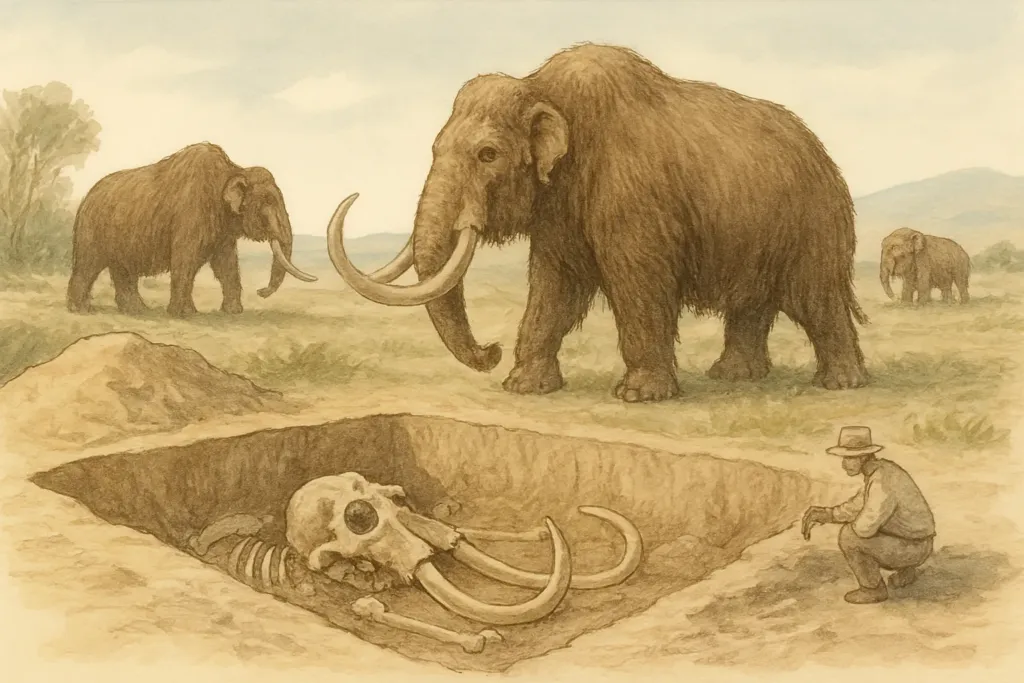Introduction
Mammoths are gone, yet their world remains visitable. From open excavations and trackways to major museums and permafrost vaults, a mammoth themed journey blends science, nature and culture. With smart planning you can see bones in situ, walk above an active dig, peek into labs and stand on the landscapes of the mammoth steppe.
Geography and what survives today
The mammoth steppe once spanned Eurasia and North America. Today the best evidence concentrates in Siberia and the Russian Arctic, Alaska and Canada, the US Great Plains, and parts of Europe. Highlights include late surviving island populations on Wrangel and St. Paul, vast bone beds in Yakutia and Western Siberia, and extraordinary concentrations in South Dakota and Texas.
Flagship places for visitors
Russia: The Mammoth Museum in Yakutsk, the Zoological Museum in Saint Petersburg and the Paleontological Museum in Moscow with full skeletons. Yakutsk’s Kingdom of Permafrost with displays in permafrost tunnels. Khanty-Mansiysk’s Archeopark with monumental sculptures. The Berelekh area in Yakutia and finds on Taimyr and Yamal are renowned but require permits and expedition logistics.
USA: The Mammoth Site in Hot Springs, South Dakota — an indoor active dig with dozens of Columbian and woolly mammoths. Waco Mammoth National Monument in Texas — a museum over a bone bed. White Sands National Park in New Mexico — trails near Pleistocene trackways including mammoth prints. Los Angeles’ La Brea Tar Pits hold Ice Age remains including mammoths.
Canada and Alaska: Yukon Beringia Interpretive Centre in Whitehorse, and the University of Alaska Museum of the North in Fairbanks.
Europe: Dolní Věstonice and Archaeopark Pavlov in the Czech Republic — mammoth hunter sites. West Runton in Norfolk, UK — the famous steppe mammoth in the regional collection. Naturalis in Leiden showcases North Sea mammoth bones. Major museums in Paris, London, Berlin, Brno and Siegsdorf hold significant specimens.
Digs and active sites
Plan to see excavations where boardwalks and shelters exist. In Hot Springs visitors view bones in situ and watch paleontologists at work under a roof. In Waco, trails lead to the dig with overlook platforms. In Europe most sites are conserved and interpreted indoors, while Siberian fieldwork is restricted and typically accessible only via permitted scientific programs.
Museums and exhibits
Seek Pleistocene megafauna collections that go beyond skeletons to climate, landscapes and hunter cultures. Permafrost vaults can display soft tissues and tusks, and Beringia interpretive centers explain animal and human migrations across the former land bridge.
Regional itineraries
Siberia and the Arctic — a Yakutsk museum cluster plus expedition cruises with mammoth lectures. United States — the South Dakota and Texas duo, adding White Sands and La Brea. Europe — Moravia and Norfolk paired with big city museums. Canada and Alaska — Beringia centers, regional museums and exhibits in Fairbanks and Whitehorse.
Seasonality and best times
Arctic trips are easiest in July and August. South Dakota, Texas and Moravia are year round but most pleasant in spring and fall. Outdoor trackway trails in desert parks depend on weather and may close for high winds or extreme heat.
Ethics, law and safety
Avoid buying tusks or mammoth ivory items — restrictions exist and demand fuels illicit trade. Exporting any finds without permits is illegal. On permafrost terrain stay on marked paths and beware melt holes and slick ice. In deserts and steppe protect against sun and wind, carry water and navigation.
Practical travel tips
Time your visit to active dig sites for guided tour hours. Prebook busy museums. Use local interpretive centers to understand context. For Siberia and the Arctic secure permits, local operators and buffer time for weather.
Inspiring facts
Woolly mammoths survived on Wrangel Island to about 4,000 years ago and on St. Paul Island to roughly 5,600 years ago. Europe’s steppe mammoth was larger than the woolly, while the Columbian mammoth dominated the warmer North American plains. At White Sands ancient human and megafauna footprints, including mammoth tracks, are preserved on the bed of a vanished lake.
Why go
A mammoth themed trip fuses archaeology, paleontology and wild landscapes. You will see bones where they lay, grasp climate shifts and feel the scale of an age when people and mammoths shared the same ground.
- Glorious sea — sacred Baikal
- Finland
- Pirate places of the world: where to travel for seafaring legends
- Mongolia
- Haruto Takahashi Found Pirate Treasure in Madagascar
- Kahovka
- Pirate treasure hunting around the world: where to look without breaking the law
- Indians
- Chukchi
- Born for battle: the world’s most warlike cultures
- Nanai
- Madagaskar
- Irkutsk
- Daring to Explore Again
- Bosphorus
- Traveling to Russia
- Vienna Opera Ball
- Tuareg
- Greece
- A quick look at Lucknow: one day in the Uttar Pradesh capital











